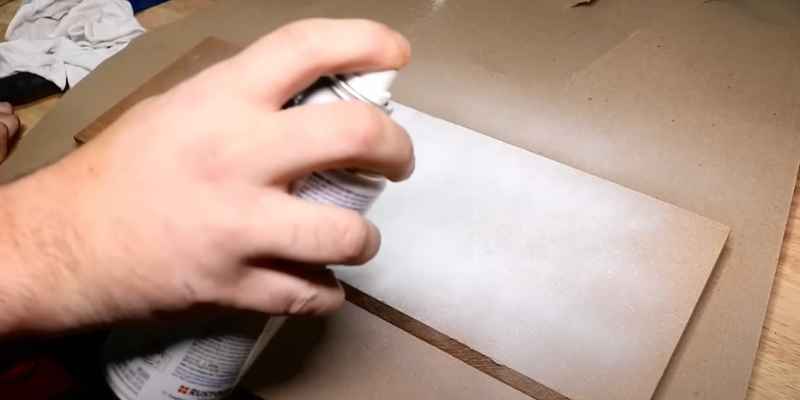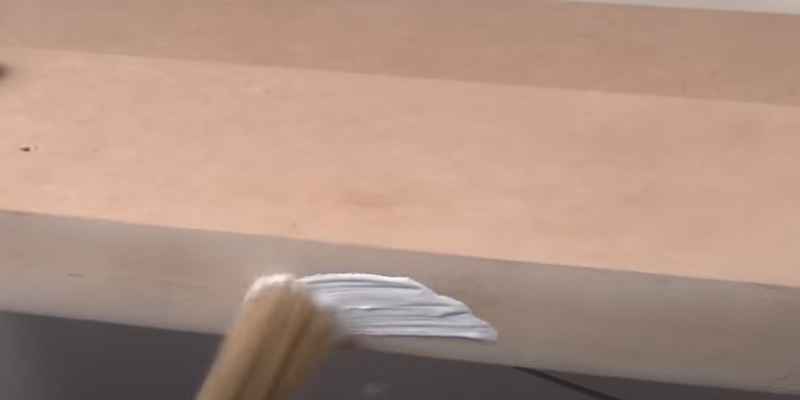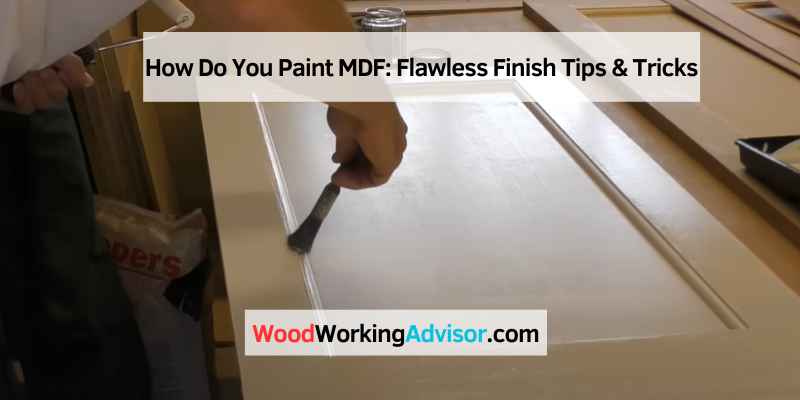To paint MDF, sand the surface, apply sanding sealer, and use oil-based or water-based paint for durability. For a smooth finish, sand and apply edge filler to the edges.
Consider using oil-based paints for large projects and water-based paints for smaller DIY tasks. It’s essential to prep the MDF properly before painting to achieve the best results. By following these steps, you can ensure a professional-looking paint job on MDF surfaces.
Remember to use high-quality primers and paints for a long-lasting and flawless finish.
Preparation For Painting
Before you start painting MDF (Medium Density Fiberboard), it is crucial to properly prepare the surface. Preparation plays a significant role in achieving a smooth and long-lasting finish. This section will guide you through the essential steps of sanding MDF, cleaning, and dust removal, ensuring that your painting project turns out perfectly.
Sanding Mdf
Sanding the MDF surface is an important step to ensure proper adhesion of the paint. Use a fine-grit sandpaper (around 220 grit) and gently sand the entire surface of the MDF. This helps to smooth out any rough spots, imperfections, or sharp edges.
Cleaning And Dust Removal
After sanding, it is vital to clean the MDF surface thoroughly to remove any dust or debris that may affect the paint application. Start by using a clean, lint-free cloth or tack cloth to wipe away the loose particles. Make sure to pay extra attention to the corners and edges.
Next, prepare a mixture of mild detergent and water. Use a sponge or soft cloth dampened with the solution to wipe down the MDF surface. This will remove any remaining dirt, grease, or stains. Rinse the surface with clean water and allow it to dry completely.
Once the surface is dry, use a vacuum cleaner or a clean, dry cloth to remove any remaining dust or debris. Take extra care to remove dust from the edges and corners of the MDF.
Now that you have completed the preparation process, your MDF is ready for painting. The next steps involve applying a primer, choosing the right type of paint, and the actual painting process.

Sealing Mdf Surfaces
To achieve a smooth paint finish on MDF, start by sealing the surface with a suitable MDF primer. Apply the primer evenly and allow it to dry before painting with your chosen paint. This process helps to prevent the MDF from soaking up too much paint, resulting in a more professional-looking finish.
Why Sealing Is Crucial
When it comes to painting MDF surfaces, sealing is a crucial step that should not be overlooked. MDF, or Medium-Density Fiberboard, is a popular choice for furniture, cabinets, and other woodworking projects due to its affordability and versatility. However, MDF has a porous nature, which means that it can absorb paint unevenly and result in a less-than-desirable finish. Sealing the MDF surface before painting helps to create a smooth and even base, ensuring that the paint adheres properly and provides a professional-looking finish.
Choosing The Right Sealer
When it comes to choosing the right sealer for MDF surfaces, there are a few options to consider. One popular choice is a water-based primer, which is easy to use and provides good adhesion. Water-based sealers also have the advantage of being low in VOCs (volatile organic compounds), making them a more environmentally-friendly option. Another option is an oil-based primer, which offers better durability and moisture resistance. However, oil-based sealers tend to have a stronger odor and longer drying times compared to water-based sealers.
Before applying the sealer, it is important to prepare the MDF surface properly. Start by sanding the surface with fine-grit sandpaper to smooth out any rough edges or imperfections. This will also help the sealer to penetrate the surface more effectively. After sanding, make sure to remove any dust or debris using a tack cloth or a damp cloth.
Once the surface is clean and dry, apply the sealer evenly using a brush or a roller. Make sure to follow the manufacturer’s instructions regarding the drying time and the number of coats needed. After the sealer has dried, gently sand the surface again with a fine-grit sandpaper to remove any raised fibers or imperfections. This will create a smooth base for the paint to adhere to.
By sealing the MDF surface before painting, you can ensure a smooth and professional-looking finish. The sealer helps to prevent the paint from being absorbed unevenly, resulting in a more even and durable paint job. So, take the time to choose the right sealer and follow the proper steps to seal your MDF surfaces before painting, and you will be rewarded with a beautiful and long-lasting finish.
Applying Primer
To paint MDF, start by applying a primer to seal the surface and prevent the wood fibers from soaking up the paint. Use a high-quality primer specifically designed for MDF to ensure a smooth and even finish. Allow the primer to dry completely before applying the paint for best results.
Best Primers For Mdf
When it comes to painting MDF, applying primer is an essential step that cannot be overlooked. The right primer will not only help the paint adhere better to the surface but also prevent the MDF from absorbing too much paint, resulting in a smoother finish. Here are some of the best primers for MDF:
- Zinsser B-I-N Shellac-Based Primer: This primer is perfect for MDF as it dries quickly and offers excellent adhesion. It also blocks stains and odors, making it an ideal choice for kitchen cabinets or furniture.
- Kilz Original Multi-Surface Stain Blocking Interior Oil-Based Primer: This primer is perfect for high-traffic areas as it offers superior stain and odor blocking properties. It also provides an excellent base for both oil-based and water-based paints.
- Behr Premium Plus Interior/Exterior Multi-Surface Primer & Sealer: This primer is a versatile option as it can be used on both interior and exterior surfaces. It offers excellent adhesion and seals porous surfaces like MDF, ensuring a smooth finish.
Primer Application Techniques
Applying primer to MDF requires a bit of preparation and technique to ensure a smooth and even finish. Here are some primer application techniques to follow:
- Clean the surface: Before applying primer, make sure the MDF surface is clean and free of any dust or debris. Use a tack cloth or a damp cloth to wipe down the surface.
- Sand the surface: Sand the MDF surface lightly with a fine-grit sandpaper to create a smooth surface. Be sure to wear a mask to avoid inhaling any dust.
- Apply the primer: Apply the primer using a high-quality brush or a foam roller. Be sure to apply the primer in thin, even coats, and let it dry completely before applying the next coat.
- Sand between coats: Sand the surface lightly between each coat of primer to remove any imperfections and create a smooth surface for the next coat.
- Apply multiple coats: Apply multiple coats of primer until the surface is completely covered, and the MDF is no longer visible through the primer.
With the right primer and application techniques, painting MDF can be a breeze. Be sure to follow these tips for a smooth and long-lasting finish on your MDF surfaces.
Paint Selection
To paint MDF, start by sanding the surface and edges, then apply a high-quality primer. Use oil-based paint for durability and a smooth finish. Consider sealing the MDF before painting for better results. Choose the right tools and techniques for a perfect painted MDF project.
Oil-based Vs Water-based Paints
When painting MDF, consider using oil-based paints for enhanced durability. Water-based paints are suitable for smaller projects, while oil-based paints are ideal for larger residential and commercial applications.
Color Considerations
When selecting paint colors for MDF, take into account the overall aesthetics of the space. Opt for colors that complement the existing decor and create a cohesive look.
Painting Techniques
When it comes to painting MDF, the technique you use can have a significant impact on the final result. Whether you choose to brush, roll, or spray, each method has its own set of benefits and challenges. Let’s explore the best practices for achieving a flawless finish when painting MDF.
Brush, Roll, Or Spray?
When it comes to applying paint to MDF, you have three main options: using a brush, a roller, or a spray gun. Each method offers unique advantages and considerations, so it’s important to choose the approach that best suits your project and desired outcome.
Achieving Smooth Edges
One of the key challenges when painting MDF is achieving smooth edges. The material can be prone to absorbing paint unevenly, resulting in a blotchy or inconsistent finish. To address this, it’s essential to employ techniques that ensure the edges are seamlessly coated and integrated with the rest of the surface.
Applying The Final Coats
To paint MDF, start by applying a primer to seal the surface and improve paint adhesion. Next, use a roller or brush to apply thin, even coats of paint, allowing each coat to dry before applying the next. Finally, sand lightly between coats for a smooth finish.
Timing Between Coats
When applying the final coats of paint on MDF, the timing between coats is crucial to achieve a smooth and professional finish. It is essential to follow the manufacturer’s instructions on the paint can for the recommended drying time between coats. Typically, you should allow the first coat to dry completely before applying the second coat. This ensures that the paint adheres properly and prevents any potential issues with the finish.
Sanding Between Coats
Sanding between coats is an important step in the painting process for MDF. After the first coat has dried completely, lightly sand the surface with fine-grit sandpaper to remove any imperfections and create a smooth base for the next coat. Be sure to wipe away any dust before applying the subsequent coat of paint. This process helps to achieve a flawless and professional-looking finish on the MDF surface.
Finishing Touches
After applying the base coat and any desired decorative finishes, it’s time to add the final touches to your MDF project. The finishing touches not only enhance the aesthetic appeal but also provide protection and durability to the painted surface.
Protective Top Coats
Applying a protective top coat is essential to safeguard the painted MDF from scratches, moisture, and general wear and tear. Polyurethane and varnish are popular choices for top coats. They create a durable and smooth finish, enhancing the overall look of the painted MDF while providing a protective layer.
Curing Time And Care
Once the protective top coat is applied, allow the painted MDF to cure properly. Ensure adequate ventilation during the curing process to facilitate proper drying. Additionally, handle the painted MDF with care during this period to avoid any damage to the freshly applied finish.

Frequently Asked Questions
What Type Of Paint Do You Use On Mdf?
Both oil-based and water-based paints can be used on MDF, but oil-based paints are preferred for their durability. Water-based paints are recommended for small DIY projects, while oil-based paints can be used for larger residential or commercial purposes. It’s important to properly prepare the surface of the MDF by sanding and applying a sanding sealer before painting.
What Do You Use To Seal Mdf Before Painting?
To seal MDF before painting, sand the surface and apply sanding sealer. For the unfinished edges, sand and apply edge filler. This will create a smooth and even surface for painting.
What Is The Best Primer For Mdf?
The best primer for MDF is a high-quality oil-based primer. It provides excellent adhesion and durability for MDF surfaces. Water-based primers can also be used for small DIY projects. However, for larger residential and commercial purposes, oil-based primers are recommended.
It is important to sand and apply sanding sealer before priming the MDF surface for a smooth finish.
What Is Ready To Paint Mdf?
Ready to paint MDF is a type of MDF (Medium Density Fiberboard) that comes with a film on its surface, making it easier to paint than regular MDF. The film allows for better paint absorption and creates a smoother finish.
It is ideal for DIY projects such as furniture, cabinets, and decorative items.
Conclusion
To achieve a smooth finish when painting MDF, remember to sand, apply sealer, and use the right primer. Opt for oil-based paints for durability on MDF surfaces. Seal edges and follow a systematic painting process for a flawless outcome. With proper preparation and technique, painting MDF can result in professional-looking finishes.


